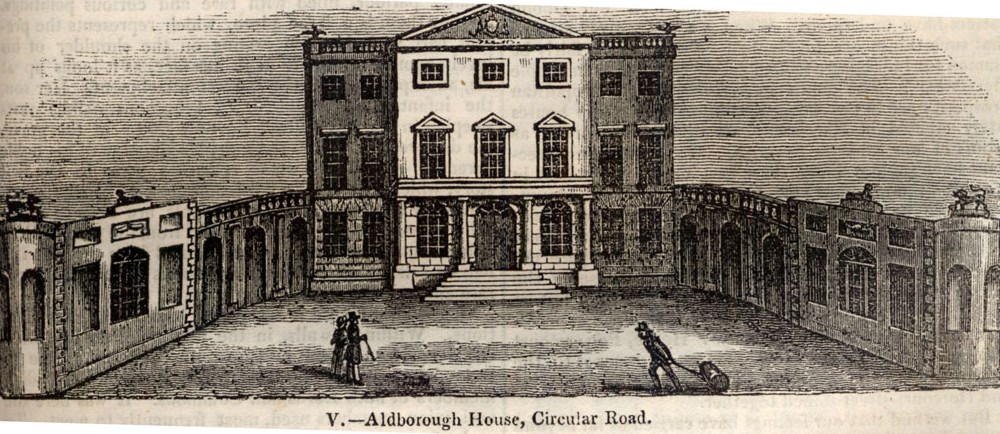In 1813, Professor Gregory (von) Feinaigle arrived in Dublin. His life to this point had been quite varied. Formerly a Cisterican monk, he had been expelled from the Monastery of Salem during the Napoleonic Wars, and after a brief dalliance as an industrialist, he moved into the education. He established himself in Karlsruhe, then moved to Paris, continued touring France, and arrived in London in 1811. After tours to Glasgow and Edinburgh, Feinaigle arrived in Dublin in January 1813. He would never leave.
Feinagle’s speciality was mnemonics, and their use as a tool in learning. Anxious to cultivate confidence among the nobility and gentry of Dublin, he quickly advertised his talks within a few weeks of his arrival. Proceeds from his talk held in the Rotunda rooms on his New System of Mnemonics were given to aid the Fund for establishing the Dublin Female Penitentiary and the Richmond National Institute of the Industrious Blind. Feinaigle clearly had a sense of how to get his name out among the classes willing to pay for his services; the latter talk was attended by the Duchess of Richmond. Announcements carrying details of the talk included information for those interested that a course on:
the Principles of Mnemonics and Methodics, will likewise begin next Wednesday the 15th of January new private lectures on the Latin language principally intended for children of former subscribers of such pupils as will be presented by them. These young pupils will at the same time be instructed in other important objects of learning, such as History, Geography, Arithmetic, etc., and may receive further instruction in other languages. The price of these private lectures is one guinea a week. The subscription to be made at No. 12 Upper Sackville Street.
Something of a craze for Feinaiglianism quickly emerged. The self-styled Professor was encouraged to establish a school, and by August 1813, Saunder’s News-Letter carried an advertisement announcing that two contiguous and eligible houses at Clonliffe had been acquired to house a seminary for the education of youth after the system of Professor von Feinaigle. Information and enquiries about the school could be obtained from Bindon Blood of Charlemont St, Richard Williams of Drumcondra Castle (both trustees), Thomas Williams of Bank of Ireland, or Dr Harty of Gloucester St.
Such were the numbers interested in applying, the Clonliffe houses were deemed too small, and Feinaigle himself advanced £4,800 to purchase Aldborough House, then unoccupied. The Clonliffe houses were retained for the female school. Forty subscribers paid £100, and £15,000 was expended on fitting the school up. This included the erection of a large hall and chapel as wings to the original building.
The school had three assistant lecturers (Rev William Lawler, Rev Piers Gamble, Mr Flynn), and named lecturers in Drawing (Mr Sandford), Natural and Experimental Philosophy (Rev Lawler), Chemistry (Michael Donovan), a Physician (William Harty), a Surgeon (Arr. Collis), and an apothecary (John Donovan). Prof Walter Wade of the Dublin Society was a guest lecturer delivering courses in botany and agriculture.
After moving into Aldborough, the name of the building was changed to The Luxembourg, and indeed is marked as such on one map of Dublin (1821). It became one of the most successful Protestant schools in Ireland, providing students for Trinity College Dublin. Pupils called it “The Lux”, and among several pupils recalled in an 1874 article in the Irish Builder were James Caulfield, future Earl of Charlemont, Abel La Touche, Sir William and Sir Croker Barrington, as well as boys from Kilkenny, Donegal, Cork, and France.
The school had become a success quickly and was now a significant provider of expensive education for children of wealthy parents. Feinaigle decided to marry, and chose for his bride a widow, a former matron at the Rotunda. Sadly his success came to an abrupt end with his sudden death in 1820. He left a significant legacy at the time. Enrolment in the school was about 130, and schools after his system were being established in other towns in Ireland. Feinaigle’s own son Charles Gregory graduated from The Lux and entered Trinity College in 1834. However, Dublin was changing; this part of the city was deteriorating quickly, and a new master (Feinaigle’s step son) intent on pursuing an overtly religious curriculum put many parents off. The school closed and Aldborough House was abandoned once more until it was taken over by Dublin Castle to house soldiers during Daniel O’Connell’s monster meeting at Clontarf.
The Feinaiglian system never gained the acceptance that the Lancaster “monitorial” system did; the latter becoming standard in classrooms around the country. But Feinaigle is immortalised in Don Juan by Byron (1818), which includes in its first canto:
Her memory was a mine; she knew by heart
All Calderon and greater part of Lopé,
So that if any actor missed his part
She could have served him from the prompter’s copy;
For her Feinaigle’s were an useless art,
And he himself obliged to shut up shop
He could never make a memory as fine as
That which adorn’d the brain of Donna Inez.
The current status of Aldborough House is well documented on the Irish Aesthete’s website. You can receive email updates when a new post is published by subscribing below.
Notes
Michael Quane (1964) The Feinaiglian Institution, Dublin, Dublin Historical Record, 19(2), 30-44.


